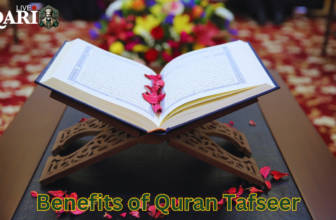
What is Qirat in the Quran?
Qirat in the Quran means the various ways to recite its verses. The term “qirat” is used in the Quran multiple times to promote its reading among Muslims. In certain verses, God emphasizes the importance of qirat for Quranic recitation.
And [it is] a Quran which We have separated [by intervals] that you might recite it to the people over a prolonged period. And We have sent it down progressively. (Al-Isra:106)
Who would then recite it to the deniers [in fluent Arabic] still, they would not have believed in it! (Ash-Shu’ara:199)
Qirat Meaning/meaning of Qirat
The word “qirat” is derived from the Arabic root “q-r-’,” meaning “to read” or “to recite.” Qirat simply means the different ways Muslims recite the Quran. It’s like having different styles of saying the same thing, where each style follows special rules for speaking the words clearly and beautifully.
These styles have been taught from one generation to another, starting from the Prophet Muhammad. It’s not just about reading the Quran out loud; it’s about understanding and feeling the words deeply. Qirat is a special part of being Muslim, showing love for the Quran by saying it in a special, careful way that has been done for centuries.

What is Qirat in Hadith
Beyond its mentions in the Quran, the word “qirat” also finds its place in various hadiths. Though literally a fragment of a dinar, its symbolic use often points to a measure of reward. Specific hadiths shed light on the nuanced role of “qirat” in indicating rewards or consequences for distinct actions.

Salim bin’ Abdullah narrated that his father said: “I heard Allah’s Messenger (PBUH) saying, “‘The period of your stay as compared to the previous nations is like the period equal to the time between the `Asr prayer and sunset. The people of the Torah were given the Torah, and they acted (upon it) till midday.”
- Then, they were exhausted and were given one qiraat (of gold) each. And then the people of the Gospel were given the Gospel, and they acted (upon it) till the `Asr prayer, then they were exhausted and were given one qirat each. And then we were given the Quran, and we acted (upon it) till sunset, and we were given two qiraats each. You have given them two qiraats and given us one qirat, though we have worked more than they.’ Allah said, ‘Have I usurped some of your rights?’ They said, ‘No.’ Allah SWT said: “That is my blessing I bestow upon whomever I wish.” [Sahih Bukhari]
- On another occasion, Salim bin’ Abdullah narrated that his father said: “The Messenger of Allah said: ‘Whoever keeps a dog, except a dog for herding livestock or a dog for hunting, one qirat will be deducted from his reward each day.’ Abdullah said: “Abu Hurairah said: ‘Or a dog for farming.’” [Sunan An-Nasa’i]
The History of Qiraat Quran
The very first copies of the Quran didn’t have the little dots and marks that show vowels and certain letter sounds. During the time of the third leader after the Prophet Muhammad, named Uthman, the official version of the Quran was made. Uthman chose a particular way of writing the Quran that allowed for different styles of reading it, and he left out some details on purpose.
Over time, people started to understand the Quran better and made the writing clearer by:
- Adding dots to tell apart letters that look alike.
- Using colored ink to highlight vowels and other sounds.
- Changing the way some markings were used for today’s Arabic writing.
Experts like Yahya ibn Ya’mar and Nasr ibn ‘Aasim, with the go-ahead from a leader named Al-Hajjaj, also helped make these letters easier to tell apart.
What Is Qirat in Islam and How to Learn Them Effectively
Qirat meaning in Islam refers to the various authentic manners of reciting the Quran, each with its own rules of pronunciation and intonation. These methods stem from the way Prophet Muhammad recited the Quran, ensuring a faithful transmission of the holy text as intended.
Learning qirat effectively involves a structured approach:
Difference between Tajweed and Qirat:
Understanding Tajweed and Qirat
Sometimes, people get mixed up between Tajweed and Qirat, but they’re not the same thing. Qirat is about the different ways you can recite the Quran, kind of like different styles. Tajweed is the set of rules that help you pronounce the words in the Quran the right way.
Think of it like this: every style of Qirat uses its own set of Tajweed rules to make sure the recitation sounds just as it was when Prophet Muhammad (PBUH) taught it to his friends. Tajweed is really important because it makes sure you’re reading the Quran the way it was meant to be read, which is something the Quran itself talks about:

In the Quran, it says that those who read the book the way it should be read are the ones who truly believe in it. And for those who don’t, they’re missing out. (Refer to Al-Baqarah:121 for this concept).
So, while Qirat is about the style of recitation, Tajweed is about making sure that whatever style you choose, you’re pronouncing everything just right.
10 qirat of Quran
There are 10 special ways to recite the Quran, which is Islam’s holy book. These are known as the 10 Qirat. The Prophet Muhammad received the Quran in Arabic, and Muslims aim to read it as it was first given.
Famous reciters taught these ten Qirat styles over time. They’re important because they show the right way to read the Quran.
Even though each style sounds a bit different in terms of voice and tune, they all share the same message. These styles, including the 7 Qirat, add beauty to the Quran’s recitation and can make it easier to learn by heart. Different places in the Muslim world prefer different styles, and each one has its own set of recitation rules. Many believe that reading the Quran in these various styles can bring a person closer to God.
How to learn the qirat of Quran?
Learning how to recite the Quran with qirat, which is the special way of pronouncing Quranic Arabic, can be quite fulfilling. Now, thanks to online resources like Qari. Live, it’s easy to start learning no matter where you are in the world. This platform offers an online course that covers the Ten Qirat, suitable for both Muslims and those in non-Muslim countries.
Professional Quran tutors conduct these Online Quran Classes, guiding you through each recitation style. They’ll also answer questions like how to become a skilled reciter, known as a Qari, and explain the role of qirat in daily prayers. Signing up for these classes can set you on a path to understanding the Quran’s recitation in depth. So, if you’re interested, you can join these classes and begin your journey in mastering qirat. Peoples who want to recite Quran with beautiful recitation, Join 10 Qirat Course at Qari.live.
Quranic Orthography
The earliest versions of the Quran didn’t have the special marks we use now for vowels or to tell similar letters apart. When the third leader after the Prophet Muhammad, Uthman (RA), made official copies of the Quran, he used a writing style that allowed room for different reading methods.
However, this caused some confusion and disagreement among people about the correct way to read the Quran because everyone was reading it a bit differently. Uthman (RA) solved this by choosing one standard way for everyone to follow.
As time went on, people made the writing in the Quran clearer. By the end of the first century, they started adding dots to help tell some letters apart. They also used different colours of ink to show vowels and sounds. Later on, they stopped using different colours and started using the marks that are part of written Arabic today.
Some well-known experts, Yahya ibn Ya’mar and Nasr ibn ‘Aasim were asked by a leader named Al-Hajjaj during the time of Caliph Abd al-Malik to put these dots in the Quran to make reading easier. Although the exact details of how and when these changes were made aren’t clear, we know that they started to appear in Qurans from that time.
Conclusion
Qirat means the different ways Muslims read the Quran, with each style having its own rules to make sure it sounds right. These styles go back to how Prophet Muhammad taught the Quran. Over time, scholars made the Quran easier to read by adding marks and dots. Anyone can learn these styles, often through the Ten Qirat Course. The styles are all correct and keep the Quran’s message the same, even though they sound a little different.
FAQs About Different Qirat of The Quran
Can I choose any Qirat style I like for reciting the Quran?
Yes, you can choose any Qirat style. All Recitation styles are linked back to the Prophet Muhammad and are correct ways of reciting.
Is it possible to learn all 10 different Qirat styles?
Yes, it’s possible to learn all 10. At the Aya Institute, some teachers can help you learn each one properly.
What’s the difference between Ahruf and Qirat?
Ahruf refers to the different ways the Quran was originally revealed, which doesn’t change the meaning. Qirat are the methods of reciting the Quran based on these Ahruf.
Can I use modern Arabic dialects to read the Quran?
No, modern Arabic dialects are different and shouldn’t be used to recite the Quran. The Quran should be recited in the original Ahruf it was revealed in, which the Qirat styles are based on and which don’t have contradicting meanings.
Are there different types of Qiraat?
Absolutely, the Quran can be recited in 7 distinct styles, which are known as the types of Qira’at. If you’re wondering which one is the correct version, don’t worry. Every Qiraat has been passed down properly from person to person, all the way back to the Prophet Muhammad. This just proves how well the Quran has been kept safe and unchanged since Allah first revealed it.







